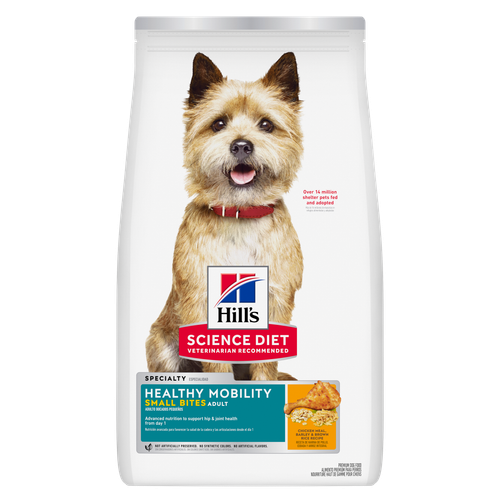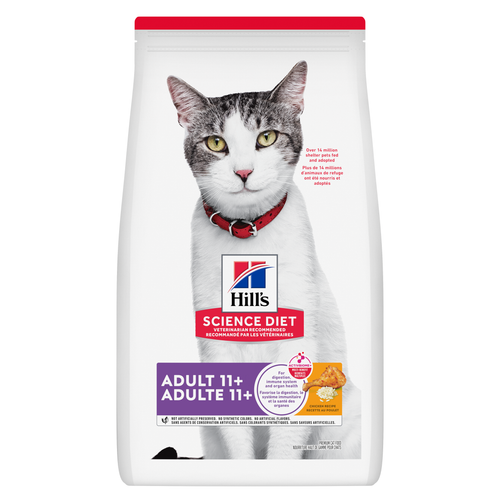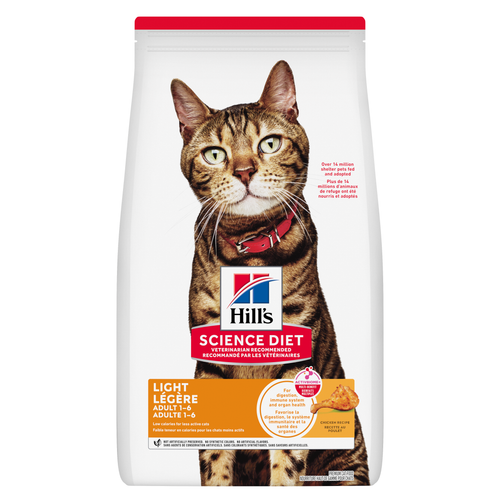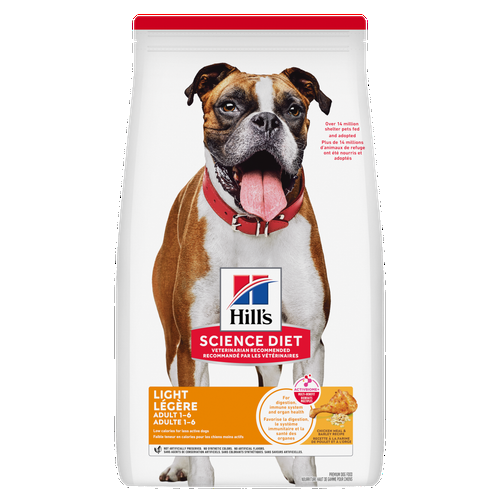
-
Find the right food for your petTake this quiz to see which food may be the best for your furry friend.Find the right food for your petTake this quiz to see which food may be the best for your furry friend.Featured products
 Adult Light Large Breed Chicken Meal & Barley Recipe Dog Food
Adult Light Large Breed Chicken Meal & Barley Recipe Dog Food18% lower calories vs. Science Diet Large Breed Adult
Shop Now Adult Sensitive Stomach & Skin Small & Mini Chicken Recipe Dog Food
Adult Sensitive Stomach & Skin Small & Mini Chicken Recipe Dog FoodHill's Science Diet Sensitive Stomach & Skin Small & Mini dry dog food is tailored nutrition for Small & Mini dogs while being gentle on stomachs. Nourishes skin & promotes a lustrous coat.
Shop Now Adult Healthy Mobility Small Bites Chicken Meal, Barley & Brown Rice Recipe Dog Food
Adult Healthy Mobility Small Bites Chicken Meal, Barley & Brown Rice Recipe Dog FoodAdvanced nutrition to support hip & joint health from day 1
Shop NowFeatured products Adult 11+ Chicken Recipe Cat Food
Adult 11+ Chicken Recipe Cat FoodSupports brain health & beautiful fur. Helps keep immune system, heart & kidneys healthy.
Shop Now Adult Healthy Cuisine Seared Tuna & Carrot Medley Cat Food
Adult Healthy Cuisine Seared Tuna & Carrot Medley Cat FoodDelicious seared tuna paired with tender carrots in a mouthwatering sauce
Shop Now Adult Light Chicken Recipe Cat Food
Adult Light Chicken Recipe Cat Food20% lower calories vs. Hill's Science Diet Adult
Shop Now -
Dog
- Dog Tips & Articles
-
Health Category
- Weight
- Food & Environmental Sensitivities
- Urinary
- Digestive
- Joint
- Kidney
- Dental
- Cancer
-
Life Stage
- Puppy Nutrition
- Adult Nutrition
- Senior Nutrition
Cat- Cat Tips & Articles
-
Health Category
- Weight
- Skin & Food Sensitivities
- Urinary
- Digestive
- Kidney
- Dental
- Stress
- Cancer
-
Life Stage
- Kitten Nutrition
- Adult Nutrition
Featured articles Importance of DHA in your Pet's Food
Importance of DHA in your Pet's FoodLearn about DHA, Docosahexaenoic Acid, a natural omega-3 fatty acid that is essential in the development of the brain and nervous system in cats & dogs.
Read More Water
WaterDiscover why water is the most important nutrient for your dog or cat to live a healthy life. Find out how much water your pet should consume each day.
Read More Antioxidants
AntioxidantsUnderstand the importance of antioxidants in your dog or cat's food, and how they can help protect your pet and keep them healthy.
Read More -


You don't want to think about your dog getting sick, but staying informed can help you navigate even the most difficult situations — including cancer. Osteosarcoma is the most common bone cancer in dogs. The Morris Animal Foundation reports that more than 10,000 cases occur each year, accounting for more than 85% of all canine bone cancer diagnoses. Knowing the signs of bone cancer in dogs is an important part of getting your pal help sooner.
What Is Bone Cancer?
Osteosarcoma is a cancer of osteoblasts, which are bone stem cells. A malignant cancer, osteosarcoma spreads to other parts of the body, including the lungs, lymph nodes, skin, liver, kidney and other bones. While osteosarcoma can affect any bone in the body, it most commonly attacks the long bones of the legs, usually near the ends of the bones, and often appears around the wrists and knees. Osteosarcoma can occur in dogs of any age or breed, but older dogs and large breeds are more affected. Golden retrievers, Rottweilers, Irish wolfhounds, Great Danes, boxers, Irish setters, greyhounds, Doberman pinschers and German shepherds appear to be at increased risk for this disease.
The cause of osteosarcoma is likely genetic. Other contributing factors can include chronic inflammation associated with metal implants and prior radiation therapy. Based on a study in Frontiers in Veterinary Science, early spaying or neutering in certain breeds is another possible risk factor. While osteosarcoma is the most common type of bone cancer in dogs, other bone cancers include fibrosarcoma and chondrosarcoma. Cancer can also spread from other organs, including the prostate and mammary glands, to your dog's bones.

Signs
The most common, and often first noticed, signs of bone cancer in dogs are limping and pain in the affected leg. The degree of limping and pain can range from mild lameness to refusing to put any weight on the leg. There may also be a firm, painful swelling on the bone that has cancer. Because cancer weakens the bone, some dogs develop a pathological fracture of the affected bone, which causes sudden severe limping and pain.
Diagnosis
Your veterinarian is key in determining if your dog has any type of bone disease. Because the signs of bone cancer in dogs can mimic other conditions, like fungal or bacterial infections of the bone, they'll need to run some tests to identify what's causing your dog's pain. Preliminary testing typically includes laboratory tests on blood and urine and radiographs (X-rays) of your dog's bone. Your vet will usually also take radiographs of your dog's chest to check for any sign of metastatic cancer in the lungs.
If your vet suspects bone cancer, they'll likely recommend additional testing that can include nuclear bone scans, a bone biopsy or a bone aspiration. These procedures are done under sedation or anesthesia. A bone aspiration is a relatively noninvasive procedure; your vet will insert a needle into the bone to withdraw cells to be analyzed in a laboratory. A bone biopsy is more invasive, but it's the best way to diagnose bone cancer as it's highly accurate. With either procedure, your dog will be asleep and will receive pain medication so they don't feel any discomfort.


Tasty Tips
Treatment
Unfortunately, the long-term prognosis for osteosarcoma is poor. According to Blackwell's Five-Minute Veterinary Consult,1 15% of dogs diagnosed with osteosarcoma do manage to live for years after aggressive cancer treatment. In most cases, however, treatment is aimed at relieving pain associated with bone cancer, and remission is unlikely. With surgery alone, survival time is around four months. The good news is that a vaccine currently in testing may be able to fight cancer in dogs using their tumor cells, according to Veterinary Practice News.
For dogs diagnosed with chondrosarcoma and fibrosarcoma who receive aggressive cancer treatment, Blackwell's Consult estimates the median survival time to be greater than three years, and many dogs do well during and after treatment. If these cancers spread, however, the prognosis is poor.
Amputating the affected leg is the treatment of choice for bone cancer, whether you're hoping to stop the cancer or remove the source of pain. Limb-sparing surgery is available at a few referral surgery centers for select pups. If you're interested in this surgery, ask your vet for more information. In addition to surgery, chemotherapy and radiation therapy are both available and have varying levels of success depending on the bone cancer diagnosis. For treatment beyond surgery, work with a veterinary cancer doctor, or oncologist, to get the best cancer care for your dog.
In all dogs, pain management is a cornerstone of therapy and is always prescribed to maintain the best quality of life possible.
Can You Prevent Bone Cancer in Dogs?
While bone cancer in dogs is often a genetic issue, you can take steps to minimize your dog's risk of developing cancer, including bone cancer. Strategies include:
- If you choose to adopt a puppy from a breeder, ensure the breeder is reputable, certifies their breeding animals to be free of genetic disease and provides you with a health guarantee for your puppy.
- Keep your dog at a healthy weight and feed them a complete and balanced meal plan that's rich in antioxidants, including EPA and DHA. Obesity is an inflammatory condition that predisposes dogs to all types of cancers.
- Talk to your vet about the right time to spay or neuter your dog.
- Bring your dog to the vet once a year for a full physical examination.
- Avoid exposure to environmental toxins, such as secondhand smoke and toxic chemicals.
You want the best for your dog. And while you can't control whether they develop a certain illness, you can provide them with proper nutrition, care and love and stay informed about the best ways to monitor their health to help ensure a happy life together.
1Jr., F. S. W. K., Tilley, L. P. (2015). Blackwell's Five-Minute Veterinary Consult: Canine and Feline (6th ed.). Wiley-Blackwell.


Dr. Sarah Wooten graduated from UC Davis School of Veterinary Medicine in 2002. A member of the American Society of Veterinary Journalists, Dr. Wooten divides her professional time between small animal practice in Greeley, Colorado, public speaking on associate issues, leadership, and client communication, and writing. She enjoys camping with her family, skiing, SCUBA, and participating in triathlons.
Related products

18% lower calories vs. Science Diet Large Breed Adult

Advanced nutrition to support hip & joint health from day 1

Hill's Science Diet Sensitive Stomach & Skin Small & Mini dry dog food is tailored nutrition for Small & Mini dogs while being gentle on stomachs. Nourishes skin & promotes a lustrous coat.

18% lower calories vs. Science Diet Adult
Related articles

Learn basic steps & precautions for treating a cut on your dog, including what you can put on the cut, and when you should take them to the vet.

Discover how the field of dog science is giving us more and more insights into the inner workings of our furry best friends.

Learn how dogs with sensitive skin can have special dietary needs, how they can develop over time in a healthy dog, and how Hill's dog food can help.

Your dog's coat and skin are a big part of your dog's overall health. Ensure you keep your dog's coat healthy, by following these simple tips.

Put your dog on a diet without them knowing
Our low calorie formula helps you control your dog's weight. It's packed with high-quality protein for building lean muscles, and made with purposeful ingredients for a flavorful, nutritious meal. Clinically proven antioxidants, Vitamin C+E, help promote a healthy immune system.
Put your dog on a diet without them knowing
Our low calorie formula helps you control your dog's weight. It's packed with high-quality protein for building lean muscles, and made with purposeful ingredients for a flavorful, nutritious meal. Clinically proven antioxidants, Vitamin C+E, help promote a healthy immune system.

